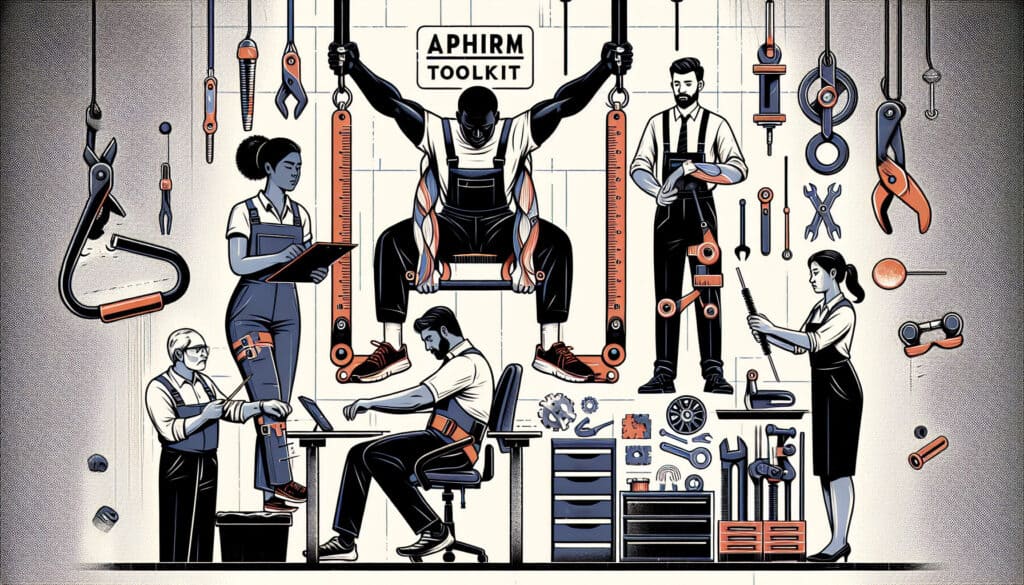مجموعة أدوات من الموارد التي تم تطويرها في أستراليا لمساعدة المؤسسات على إدارة مخاطر الاضطرابات العضلية الهيكلية.
- المنهجيات: العملاء والتسويق, الاقتصاد, تصميم المنتج
مجموعة أدوات APHIRM

مجموعة أدوات APHIRM
- التحسين المستمر, بيئة العمل, العلوم الصحية, العوامل البشرية, تحسين العمليات, إدارة الجودة, إدارة المخاطر, أمان, ممارسات الاستدامة
الهدف:
كيفية استخدامه:
- توفر مجموعة أدوات APHIRM (مجموعة أدوات تحديد المخاطر التشاركية وإدارة المخاطر) دليلًا تفصيليًا لتحديد وتقييم ومراقبة المخاطر العضلية الهيكلية في مكان العمل. وتتضمن مجموعة من الأدوات العملية، مثل قوائم المراجعة وأوراق العمل.
الايجابيات
- يوفر إطارًا عمليًا وسهل الاستخدام لإدارة المخاطر العضلية الهيكلية، ويستند إلى نهج تشاركي، وقد تم تطويره خصيصًا لأماكن العمل الأسترالية.
سلبيات
- قد لا تنطبق على جميع البلدان أو الصناعات، وتتطلب التزامًا من الإدارة والعمال لتكون فعالة، وقد لا تكون مناسبة لجميع أنواع المخاطر العضلية الهيكلية.
الفئات:
- بيئة العمل, الموارد البشرية, إدارة المخاطر
الأفضل لـ
- إدارة مخاطر الاضطرابات العضلية الهيكلية في أماكن العمل الأسترالية.
تُعد مجموعة أدوات APHIRM ذات قيمة خاصة في صناعات مثل الرعاية الصحية والتصنيع والخدمات اللوجستية، حيث تنتشر المناولة اليدوية والمهام المتكررة. وهي قابلة للتطبيق في مختلف مراحل المشروع، بما في ذلك التصميم الأولي والتنفيذ والصيانة المستمرة. عادةً ما يبدأ فريق متعدد التخصصات، بما في ذلك مسؤولو الصحة والسلامة وأخصائيو الهندسة المريحة والعاملون في الخطوط الأمامية، عملية تقييم المخاطر، مما يضمن أن تكون الرؤى والخبرات من المتأثرين مباشرةً هي التي تُثري تقييم المخاطر. تسمح الطبيعة التشاركية لمجموعة الأدوات بتقديم مدخلات من مجموعة متنوعة من أصحاب المصلحة، مما يجعلها قابلة للتكيف مع بيئات وممارسات أماكن العمل المختلفة. تعمل الأدوات العملية، مثل قوائم المراجعة وأوراق العمل، على تعزيز المشاركة وتسهيل التطبيقات المباشرة، بغض النظر عن مستوى الخبرة الحالية في إدارة المخاطر. لا يؤدي دمج منهجية APHIRM بانتظام في برامج السلامة في مكان العمل إلى تعزيز الامتثال للوائح العمل الآمن الأسترالية فحسب، بل يشجع أيضًا على ثقافة السلامة التي تهدف إلى الحد من حدوث الاضطرابات العضلية الهيكلية. من خلال ضمان أن تكون إدارة المخاطر مسؤولية مشتركة، يمكن لأماكن العمل تعزيز الحوارات المستمرة حول تدابير السلامة، مما يؤدي إلى التحسين المستمر في الممارسات المريحة وتحسين النتائج الصحية للموظفين. ومن خلال نهجها المتكامل، تُستخدم مجموعة الأدوات أيضًا كمخطط لإجراء دورات تدريبية وورش عمل تركز على تحديد المخاطر واستراتيجيات التخفيف من حدتها، وتمكين الفرق من معالجة القضايا المتعلقة بالصحة العضلية الهيكلية بشكل استباقي.
الخطوات الرئيسية لهذه المنهجية
- تحديد المخاطر العضلية الهيكلية من خلال تقييمات وملاحظات مكان العمل.
- تقييم مستوى المخاطر المرتبطة بالمخاطر المحددة باستخدام مقاييس نوعية أو كمية.
- إشراك أصحاب المصلحة في وضع استراتيجيات رقابية للتخفيف من المخاطر المحددة.
- تنفيذ تدابير الرقابة المختارة والتأكد من إبلاغ جميع الموظفين بها.
- مراقبة فعالية الضوابط المطبقة وجمع الملاحظات من الموظفين.
- مراجعة وتحديث عملية إدارة المخاطر بانتظام لتعكس التغييرات في مكان العمل أو المخاطر الناشئة.
نصائح للمحترفين
- قم بدمج التقييمات المريحة في تقييمات سير العمل المنتظمة لتحديد المخاطر الخفية التي قد لا تكون مرئية على الفور.
- الاستفادة من حلقات التغذية الراجعة من الموظفين المشاركين في تنقيح استراتيجيات إدارة المخاطر وتحسينها باستمرار بناءً على التجارب الحقيقية.
- الاستفادة من أدوات تحليل البيانات لرصد الاتجاهات في الاضطرابات العضلية الهيكلية وتكييف التدخلات بشكل استباقي بناءً على الأنماط المحددة.
لقراءة عدة منهجيات ومقارنتها, نوصي باستخدام
> مستودع المنهجيات الشامل <
مع أكثر من 400 منهجية أخرى.
نرحب بتعليقاتكم على هذه المنهجية أو المعلومات الإضافية على قسم التعليقات أدناه ↓، وكذلك أي أفكار أو روابط متعلقة بالهندسة.
السياق التاريخي
1986
(إذا كان التاريخ غير معروف أو غير ذي صلة، على سبيل المثال "ميكانيكا الموائع"، يتم تقديم تقدير تقريبي لظهوره الملحوظ)

منشورات ذات صلة
إدارة عمليات التصنيع (MOM)
نظام تنفيذ التصنيع (MES)
خطة مراقبة التصنيع
الاختبار اليدوي
مخططات تقييم المناولة اليدوية (MAC)
أداة تقييم مخاطر المهام اليدوية (ManTRA)